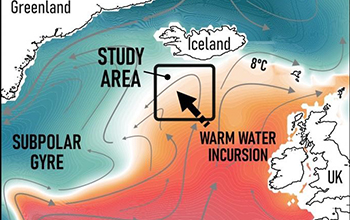搜索结果: 1-15 共查到“理学 cold-water”相关记录17条 . 查询时间(0.195 秒)

Dramatic decrease in cold-water plankton during the industrial era(图)
Dramatic decrease cold-water plankton during industrial era
2020/5/9
There was a dramatic decrease in cold-water plankton during the 20th century, in contrast to thousands of years of stability, according to a National Science Foundation-funded study by ...
BOOK REVIEW:Cold-Water Corals:The Biology and Geology of Deep-Sea Coral Habitats
Cold-Water Corals Biology and Geology Deep-Sea Coral Habitats
2015/7/7
Cold-Water Corals is the first comprehensive synthesis of one of the most active areas of current deep-sea research. It is a timely contribution to this field, which is experiencing a rapid increase i...
During HERMES cruises in spring 2006 and 2007 to a cold-water
coral (CWC) reef at the border between Norway and Sweden, we studied effects of
the reef on the quality (C/N ratio) of suspended parti...
Temperature Effects on Growth and Stress Physiology of Brook Trout: Implications for Climate Change Impacts on an Iconic Cold-Water Fish
growth stress heat shock protein cortisol
2015/1/4
Despite the threat of climate change, the physiological mechanisms by which temperature drives the distribution of species are unclear. Here we used chronic temperature exposures to determine that the...
Calcareous Nannofossil Records Of Miocene Sea Level At The Marion Plateau (Northeastern Australia); And Pliocenepleistocene Formation Of Cold Water Carbonate Mounds (North Eastern Atlantic Continental Margin),
Earth sciences Carbonate mounds Biostratigraphy Calcareous nannfossils Marion Plateau Miocene Sea level Sequence stratigraphy
2014/10/22
The revised age models for the upper Oligocene to middle Miocene interval of the Marion Plateau have been used to identify eleven sequence boundaries and sequences sets at the Marion Plateau; MSA1.2 (...
Calcareous nannofossil records of Miocene sea level at the Marion Plateau (Northeastern Australia); and Pliocene-Pleistocene formation of cold water carbonate mounds (Northeastern Atlantic Continental Margin)
Paleontology. Marion plateau Antarctica Ice Surface water quality. The glacier events
2014/10/22
The revised age models for the upper Oligocene to middle Miocene interval of the Marion Plateau have been used to identify eleven sequence boundaries and sequences sets at the Marion Plateau; MSA1.2 (...
Downwelling and deep-water bottom currents as food supply mechanisms to the cold-water coralLophelia pertusa(Scleractinia) at the Mingulay Reef complex
Downwelling and deep-water bottom currents food supply mechanisms the cold-water coralLophelia pertusap Mingulay Reef complex
2014/4/18
In 2006 and 2007, multiple deployments of current meters and optical sensors on landers and moorings were made in the first detailed in situ study of the particle supply to the coral community in the ...
The cold-water coral community as a hot spot for carbon cycling on continental margins: A food-web analysis from Rockall Bank (northeast Atlantic)
The cold-water coral community carbon cycling continental margins: A food-web analysis Rockall Bank
2014/4/17
We present a quantitative food-web analysis of the cold-water coral community, i.e., the assembly of living corals, dead coral branches and sediment beneath, associated with the reef-buildingLophelia ...
Buried sedimentary mounds in the Nyk High area,Mid-Norwegian margin:Are they Miocene-Pliocene cold-water coral mounds?
Buried sedimentary mounds Nyk High area Miocene-Pliocene cold-water coral mounds
2009/12/3
Buried sedimentary mounds in the Nyk High area,Mid-Norwegian continental margin, are described from a 3D-seismic dataset and discussed in relation to modern deep-water sedimentary mounds. The mounds a...
Calcification of the cold-water coral Lophelia pertusa,under ambient and reduced pH
Calcification cold-water coral Lophelia pertusa ambient and reduced pH
2010/1/20
The cold-water coral Lophelia pertusa is one of the few species able to build reef-like structures and a 3-dimensional coral framework in the deep oceans. Furthermore, deep cold-water coral bioherms m...
Carbon mineralization and carbonate preservation in modern cold-water coral reef sediments on the Norwegian shelf
Carbon mineralization carbonate preservation cold-water coral reef sediments
2010/1/19
Cold-water coral ecosystems are considered hot-spots of biodiversity and biomass production and may be a regionally important contributor to carbonate production. The impact of these ecosystems on bio...
Species-specific encystment patterns in three Baltic cold-water dinoflagellates: The role of multiple cues in resting cyst formation
Species-specific encystment patterns Baltic cold-water dinoflagellates
2014/4/18
The relationships among cellular nutrient status, environmental conditions (temperature and nutrient
availability), and cyst production were studied in batch cultures of three cold-water dinoflagella...
Warm-to-Cold Water Conversion in the Northern North Atlantic Ocean
Warm-to-Cold Northern North Atlantic Ocean Water Conversion
2009/1/20
A box Model of warm-to-cold-water conversion in the northern North Atlantic is developed and used to estimate conversion rates, given water mass temperatures, conversion paths and rate of air-sea heat...
Tourism in Cold Water Islands: A Matter of Contract?Experiences from Destination Development in the Polar North.
Polar North tourism globalization climate change cruise ship contract
2010/9/13
Lack of local understanding and low preparedness for tourism characterise many remote communities of the Polar North, thus undermining positive attitudes towards tourism even if tourism is seen as a d...
A bush, not a tree: The extraordinary diversity of cold-water basal foraminiferans extends to warm-water environments
A bush not a tree extraordinary diversity cold-water basal foraminiferans extends warm-water environments
2014/4/18
Foraminiferal species distribution and richness have traditionally been assessed through examination of the shells (tests) built by most of the described species, but molecular surveys indicate that t...

